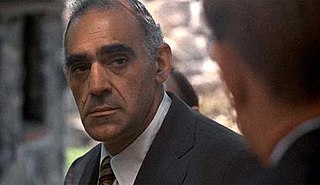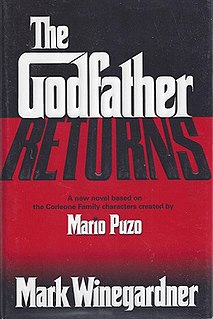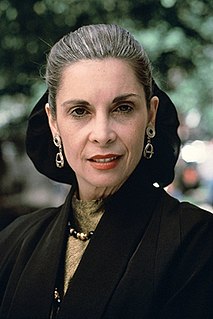
The Godfather is a crime novel by American author Mario Puzo. Originally published in 1969 by G. P. Putnam's Sons, the novel details the story of a fictional Mafia family in New York City, headed by Vito Corleone, the Godfather. The novel covers the years 1945 to 1955 and includes the back story of Vito Corleone from early childhood to adulthood.

Michael Corleone is a fictional character and the main protagonist of Mario Puzo's 1969 novel, The Godfather. In the three Godfather films, directed by Francis Ford Coppola, Michael was portrayed by Al Pacino, for which he was twice-nominated for Academy Awards. Michael is the youngest son of Vito Corleone, a Sicilian immigrant who builds a Mafia empire. Upon his father's death, Michael succeeds him as the don of the Corleone crime family.

Vito Corleone is a fictional character in Mario Puzo's 1969 novel The Godfather and in the first two of Francis Ford Coppola's film trilogy. Vito is originally portrayed by Marlon Brando in the 1972 film The Godfather, and later by Oreste Baldini as a boy and by Robert De Niro as a young man in The Godfather Part II (1974). He is an orphaned Sicilian immigrant who builds a Mafia empire.

Federico Corleone is a fictional character in Mario Puzo's 1969 novel The Godfather. Fredo is portrayed by American actor John Cazale in the Francis Ford Coppola 1972 film adaptation and in the 1974 sequel, The Godfather Part II.

Santino "Sonny" Corleone is a fictional character in Mario Puzo's 1969 novel The Godfather and its 1972 film adaptation.

Mary Corleone is a fictional character in The Godfather Part III, portrayed by Sofia Coppola. She is the daughter of Michael Corleone and Kay Adams and sister of Anthony Vito Corleone.

Thomas Hagen is a fictional character in Mario Puzo's 1969 novel The Godfather and Francis Ford Coppola's films The Godfather (1972) and The Godfather Part II (1974). He is portrayed by Robert Duvall in the films. He also appears in the Mark Winegardner sequel novels, The Godfather Returns and The Godfather's Revenge, as well as Ed Falco's novel, The Family Corleone.

Katherine Corleone is a fictional character in Mario Puzo's 1969 novel The Godfather. She was portrayed by Diane Keaton in Francis Ford Coppola's trilogy of films based on the novel.

Peter Clemenza is a fictional character who first appeared in Mario Puzo's 1969 novel The Godfather. He is played by Academy Award-nominee Richard Castellano in Francis Ford Coppola's 1972 film adaptation of the novel, and by Bruno Kirby in The Godfather Part II (1974).

Salvatore "Sal" Tessio is a fictional character in Mario Puzo's 1969 novel The Godfather, as well as two of the films based on it: The Godfather (1972) and The Godfather Part II (1974). His given name was created for the films; in the novel he is referred to only as "Tessio". In the film The Godfather, Tessio was portrayed by Abe Vigoda. In The Godfather Part II, John Aprea portrayed the younger Tessio, while Vigoda reprised the role in a flashback, set in late 1941, at the end of the film.
Anthony Vito "Tony" Corleone is a fictional character in The Godfather trilogy of films directed by Francis Ford Coppola. He is the son of Michael Corleone and Kay Adams, and the older brother of Mary Corleone. While Anthony was never a major character in the first two films, major events in his life were the backdrop of key parts of the second film, and his relationship with his father is a plot point in the third film.

Albert Neri is a fictional character appearing in Mario Puzo's 1969 novel The Godfather and Francis Ford Coppola's trilogy of films based on it. In all three motion pictures, he is portrayed by actor Richard Bright. He functions as Michael Corleone's personal enforcer, bodyguard and assassin.

The Godfather Returns is a novel written by author Mark Winegardner, published in 2004. It is the sequel to Mario Puzo's 1969 novel The Godfather and The Sicilian (1984). The publisher, Random House, selected Winegardner to write a sequel after Puzo's death. As the original novel covered the years 1945 to 1955, and included significant backstory on Don Vito Corleone's life, Returns covers the years 1955 to 1962, and includes significant backstory on Michael Corleone's life prior to the first novel. It is the third book in The Godfather series of novels.

The Godfather's Revenge, a 2006 novel written by author Mark Winegardner, is the sequel to his 2004 novel The Godfather Returns. It is the fourth book in The Godfather novel series and is chronologically set last.
Mark Winegardner is an American writer born and raised in Bryan, Ohio. His novels include The Godfather Returns, Crooked River Burning, and The Veracruz Blues. He published a collection of short stories, That's True of Everybody, in 2002. His newest novel, The Godfather's Revenge, was published in November 2006 by Putnam. His Godfather novels continue the story of the Corleone family depicted in Mario Puzo's The Godfather.
William Brewster Van Arsdale III is a fictional character in Mark Winegardner's 2004 novel The Godfather Returns.
Michael Corbett Shea is a fictional character who is featured prominently in the 2004 novel The Godfather Returns. He is loosely based on bootlegger and former United States Ambassador Joseph P. Kennedy, the father of U.S. president John F. Kennedy, United States Attorney General and Senator Robert F. Kennedy, and United States Senator Ted Kennedy.

Constanzia "Connie" Corleone is a fictional character in The Godfather, a 1969 novel by Mario Puzo, and the 1972 film The Godfather. In the film, Connie is portrayed by Talia Shire, the sister of the director Francis Ford Coppola. Shire was nominated for the Academy Award for Best Supporting Actress for her portrayal of Connie Corleone in The Godfather Part II.

The Godfather book series is a series of crime novels about Italian-American Mafia families, most notably the fictional Corleone family, led by Don Vito Corleone and later his son Michael Corleone. The first novel, The Godfather, written by Mario Puzo, was released in 1969. It was adapted into a series of three feature films, which became one of the most acclaimed franchises in film history.














